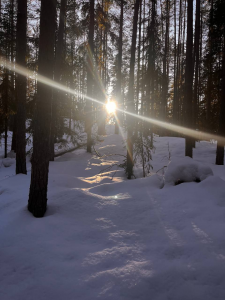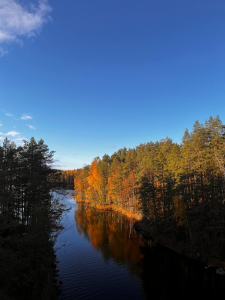
Finnish forest
Vol. 26, Issue 17, 16 Febrary 2024
Three quarters of Finland’s area is covered by forests, which contain a total of up to 30 tree species. Finnish timber companies are among the world leaders in the industry. The most important types of products they produce are paper, cardboard, and wood products. The chemical industry, transport, and energy are working in close cooperation with the foresters.
The forest is a component of the national identity of the Finns, a source of inspiration in fine art and photography, literature, architecture. The right of universal access to land, regardless of the form of ownership, provides the opportunity to relax in nature and use its gifts. Free collection of mushrooms and berries is allowed on plots of any form of ownership. You can freely travel through the Finnish forests on foot, skiing, cycling and horseback. Most of the inhabitants of Finland regularly visit nature, relax in dachas. Almost 300 thousand Finns are avid amateur hunters. For many years, the annual growth of Finnish forests has been at the level of over 100 million cubic meters. In the cold climate of Finland, the growing season is short and lasts only about 100 days. In 2016, the growth of wood amounted to 109.9 million cubic meters, based on this, the average daily increase was about 1 million cubic meters. In recent years, the stock of stands in Finland has increased significantly. There is an average of 111 cubic meters of growing wood per hectare of forest, whereas back in the 70s the volume was 75 cubic meters per hectare.

One of the indicators of the state of forest biological diversity is the amount of rotten wood in the forest. Humans can contribute to maintaining the living conditions of change-sensitive and endangered species by applying forest care methods that are close to natural processes, that is, by increasing the amount of rotten wood in commercial forests. It is estimated that in Finland there are about 4,000-5,000 species of flora and fauna directly dependent on the presence of rotten wood, which is one fifth of the total number of forest plant and living species in Finland. In addition to them, there are species in nature that indirectly depend on food and protection provided by rotten trees, for example, the white-backed woodpecker and other birds nesting in hollows.

Forests used according to the principle of sustainable development are an inexhaustible source of raw materials. Growing trees absorb carbon from the air, which is stored in the tree throughout their entire life span. One cubic meter of wood absorbs about a ton of carbon dioxide. The active use of wood material contributes to the rapid renewal of forests. A growing forest absorbs more carbon dioxide than an adult forest. The annual expenditure of the country’s budget for the needs of reforestation and forest care amounts to more than 200 million euros. Moreover, a third of this amount is financed by forest owners (in Finland, one in five families has such funds). Up to 60% of the country’s forest resources are concentrated in the private or family ownership of Finns. Both public and private forest lands are subject to the Forest Law, which is designed to promote sound forest management and prohibits extensive logging in growing young forests, as well as logging at too early a stage.
- New Year’s mood - 22nd November 2024
- Minimalism is a way of life. Where to begin? - 15th November 2024
- Why do you need an air humidifier? - 8th November 2024
